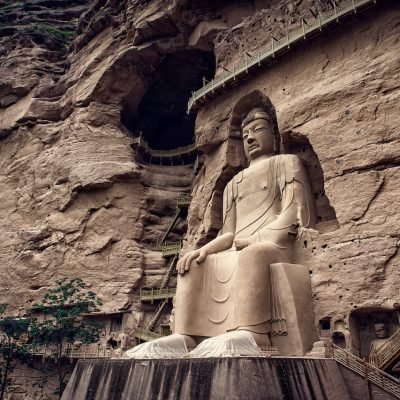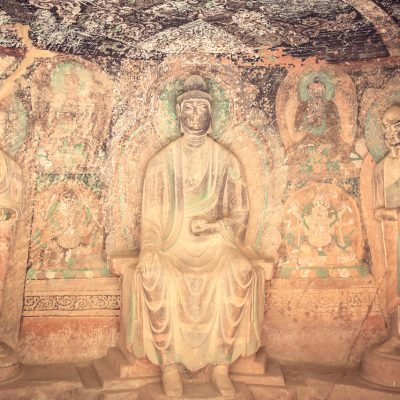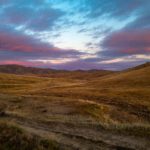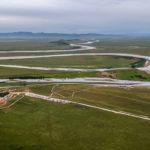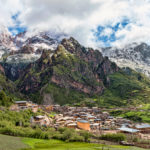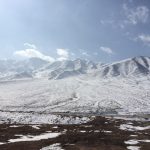With a 1.5 hour drive from Lanzhou, the capital of Gansu, this is a very accessible day trip from Lanzhou. You could also do this trip as a larger itinerary that continues onto Labrang monastery or Hezuo and Langmusi as well which are in southern Gansu Province.
The Bingling Caves were a work in progress for more than a millennium. The first grotto was begun around 420 AD at the end of the Western Qin kingdom. Work continued and more grottoes were added during the Wei, Sui, Tang, Song, Yuan, Ming, and Qing dynasties. The style of each grotto can easily be connected to the typical artwork from its corresponding dynasty. The Bingling Temple is both stylistically and geographically a midpoint between the monumental Buddhas of Bamiyan in Afghanistan and the Buddhist Grottoes of central China, such as the Yungang Grottoes near Datong and Longmen Grottoes near Luoyang.
Sadly, over the centuries, earthquakes, erosion, and looters have damaged or destroyed many of the caves and the artistic treasures within. Altogether there are 183 caves, 694 stone statues, and 82 clay sculptures that remain. The relief sculpture and caves filled with buddhas and frescoes line the northern side of the canyon for about 200 meters along the reservoir. Each cave is like a miniature temple filled with Buddhist imagery. These caves culminate at a large natural cavern where wooden walkways precariously wind up the rock face to hidden cliff-side caves as if visiting an ancient civilizaiton. It is here at the top of these steps that you can view the giant Maitreya or Future Buddha that stands more than 27 meters, or almost 100 feet tall.This 100 foot tall Buddha is the main attraction to visit Bingling Temple and is certainly worth the trip from Lazhou. As you loop around past the Maitreya cave, you might consider hiking 2.5km further up the impressive canyon to a small remote Tibetan monastery. If you do this extra hike, be aware than there may also be 4Wheel drive ATV’s There might also be 4WDs running the route.
The sculptures, carvings, and frescoes that remain are outstanding examples of Buddhist artwork and draw visitors from around the world. The site is extremely remote and can only be reached during summer and fall by boat via the Liujiaxia Reservoir. Boats leave from near the Liujiaxia Dam in Liujiaxia City (Yongjing County’s county seat), and sometimes also from other docks on the reservoir. The rest of the year, the site is inaccessible, as there are very few roads in the area because of the rocky landscape.
You can hire a covered speedboat (which seats 9 people in total) for 700 RMB per boat for the one-hour drive across the Liujiaxia Resevoir. Boats do not run unless the boat is full of the required 9 people, so you may have to wait for other guests or you may have to pay the difference to cover the empty seats. In the peak seasons from May to October it should be no problem to find other willing Chinese tourists who will want to share the boat with you. In low season, though, you may have to wait 30 minutes or more for your boat to fill up.
From Liujiaxia you can also hire a private car for around 300 RMB to take you to the other side of the reservoir, although most people opt for the boat since this gives a very nice view of the cliffs from the expansive reservoir. Out of Liújiāxiá, the road ascends the rugged hills of southern Gansu and winds above the reservoir. While the drive is quite scenic, if you are prone to motion sickness this is not the option for you as the drive is about 1.5 hours and twists and turns through terraced fields. The final descent to the turquoise reservoir, with its craggy canyon backdrop, is well worth the trip.
You can also opt to stay overnight in Liújiāxiá if you want the overnight experience. Most people do Bingling Si as a full day trip, but the Dorsett Hotel at the north end of town is a good option with huge rooms overlooking the Yellow River.
Most people hire a private car from Lanzhou, but if you are feeling more adventurous (and have some extra free time) you can take one of the frequent buses from Lanzhou’s west bus station that cost 20 RMB and take 2.5 hours to get to the Liújiāxiá bus station. From there, you will need to take a 10-minute taxi ( to the boat ticket office at the dam (大坝; dàbà). Try to catch the earliest buses possible from Lánzhōu (these start at 7am) to avoid missing the bus on the way back to Lanzhou. The last returning bus to Lánzhōu leaves Liujiaxia at 6.30pm at night.
